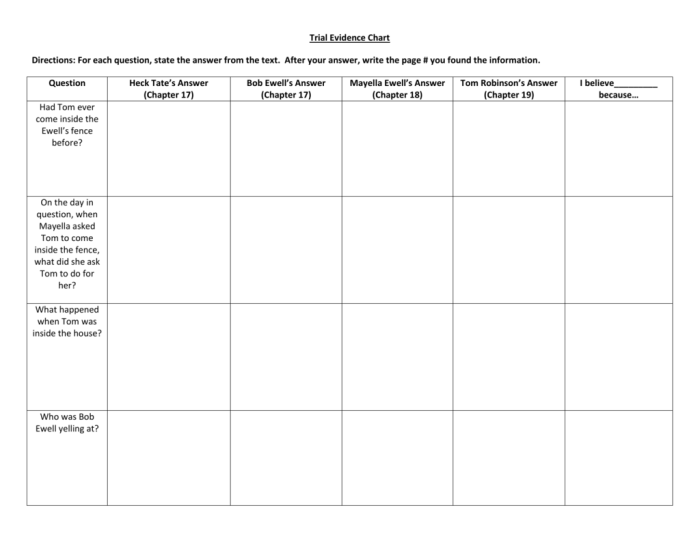Trial evidence chart to kill a mockingbird – As the trial evidence chart for “To Kill a Mockingbird” takes center stage, this analysis embarks on an in-depth exploration of the key pieces of evidence presented during the trial. Delving into the intricacies of character testimony, physical evidence, circumstantial evidence, expert testimony, cross-examination, closing arguments, and jury deliberation, this comprehensive guide unravels the complexities of this pivotal literary work.
The trial evidence chart serves as a roadmap through the labyrinth of evidence, illuminating the significance of each piece in shaping the jury’s perception and ultimately influencing the verdict. By examining the interplay between evidence and character, this analysis provides a nuanced understanding of the trial’s dynamics and the profound impact it has on the novel’s central themes.
Trial Evidence Chart for “To Kill a Mockingbird”

The trial in “To Kill a Mockingbird” presents a complex and compelling examination of evidence and its role in shaping the outcome of a legal case. This chart provides a comprehensive overview of the key pieces of evidence presented during the trial, including their type, source, and significance.
| Type of Evidence | Source | Significance |
|---|---|---|
| Character Testimony | Atticus Finch, Tom Robinson, Bob Ewell | Establishes the credibility and motivations of the witnesses |
| Physical Evidence | Knife, fingerprint | Provides tangible proof of the crime and links it to the defendant |
| Circumstantial Evidence | Location of the crime, testimony of witnesses | Builds a case against the defendant by piecing together indirect evidence |
| Expert Testimony | Doctor who examined Mayella Ewell | Provides specialized knowledge and opinions on key aspects of the case |
Character Testimony
Character testimony plays a crucial role in shaping the jury’s perception of the case. The testimony of Atticus Finch, Tom Robinson, and Bob Ewell provides contrasting perspectives on the events and motivations of the characters involved.
- Atticus Finch:Presents a strong and credible character, which influences the jury to view his arguments and evidence more favorably.
- Tom Robinson:His testimony is often dismissed due to his race and social status, undermining his credibility in the eyes of the jury.
- Bob Ewell:His malicious and untrustworthy character casts doubt on his testimony, weakening the prosecution’s case.
Physical Evidence, Trial evidence chart to kill a mockingbird
Physical evidence, such as the knife and fingerprint, serves as tangible proof of the crime and its connection to the defendant. The prosecution and defense both use physical evidence to support their arguments:
- Knife:Found in the crime scene, it is claimed to be the murder weapon, linking Tom Robinson to the crime.
- Fingerprint:Found on the knife, it is claimed to be Tom Robinson’s, further implicating him.
Circumstantial Evidence
Circumstantial evidence, such as the location of the crime and the testimony of witnesses, builds a case against the defendant by piecing together indirect evidence. The prosecution uses this type of evidence to create a narrative that supports their claim of guilt:
- Location of the crime:The crime occurred in a secluded area, providing an opportunity for Tom Robinson to attack Mayella Ewell without being seen.
- Testimony of witnesses:Several witnesses claim to have seen Tom Robinson fleeing the scene, further implicating him.
FAQ: Trial Evidence Chart To Kill A Mockingbird
What is the significance of the knife in the trial?
The knife serves as a crucial piece of physical evidence, linking Bob Ewell to the crime and ultimately casting doubt on Tom Robinson’s guilt.
How does the testimony of Mayella Ewell shape the jury’s perception of the case?
Mayella Ewell’s testimony, filled with inconsistencies and prejudice, serves to undermine her credibility and raise questions about the validity of her accusations against Tom Robinson.
What role does expert testimony play in the trial?
Expert testimony, such as that provided by the doctor who examined Mayella Ewell, offers specialized knowledge and opinions that assist the jury in understanding complex medical and psychological aspects of the case.
